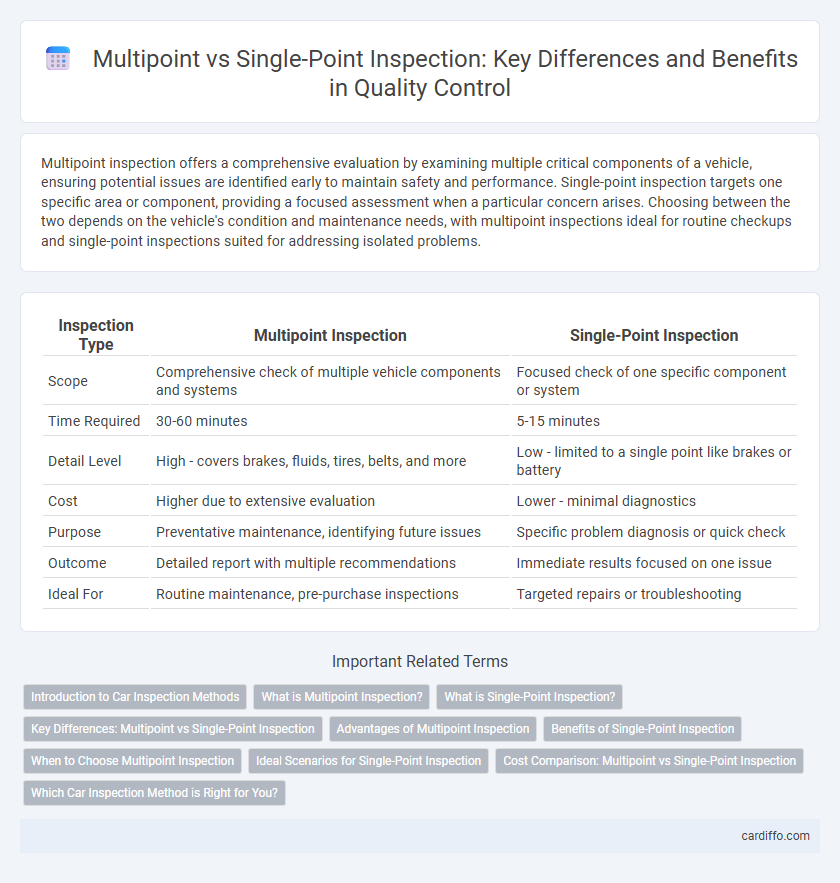Multipoint inspection offers a comprehensive evaluation by examining multiple critical components of a vehicle, ensuring potential issues are identified early to maintain safety and performance. Single-point inspection targets one specific area or component, providing a focused assessment when a particular concern arises. Choosing between the two depends on the vehicle's condition and maintenance needs, with multipoint inspections ideal for routine checkups and single-point inspections suited for addressing isolated problems.
Table of Comparison
| Inspection Type | Multipoint Inspection | Single-Point Inspection |
|---|---|---|
| Scope | Comprehensive check of multiple vehicle components and systems | Focused check of one specific component or system |
| Time Required | 30-60 minutes | 5-15 minutes |
| Detail Level | High - covers brakes, fluids, tires, belts, and more | Low - limited to a single point like brakes or battery |
| Cost | Higher due to extensive evaluation | Lower - minimal diagnostics |
| Purpose | Preventative maintenance, identifying future issues | Specific problem diagnosis or quick check |
| Outcome | Detailed report with multiple recommendations | Immediate results focused on one issue |
| Ideal For | Routine maintenance, pre-purchase inspections | Targeted repairs or troubleshooting |
Introduction to Car Inspection Methods
Multipoint inspection involves a comprehensive examination of multiple vehicle systems such as brakes, tires, engine components, and fluid levels, ensuring a thorough assessment of car condition. Single-point inspection focuses on a specific area or component, like tire pressure or brake pads, providing targeted insights but less overall vehicle health data. Multipoint inspections are preferred for preventive maintenance and early detection of potential issues, enhancing safety and vehicle longevity.
What is Multipoint Inspection?
Multipoint inspection is a comprehensive vehicle evaluation process that examines multiple critical systems and components simultaneously, including brakes, tires, engine, suspension, and fluid levels. Unlike single-point inspection, which focuses on one specific area or issue, multipoint inspection ensures a thorough assessment to identify existing problems and potential maintenance needs. This approach helps extend vehicle lifespan, improve safety, and optimize performance by addressing all relevant factors in a single service visit.
What is Single-Point Inspection?
Single-point inspection involves examining a specific component or system of a vehicle, such as brakes or tires, to quickly assess its condition. This targeted approach allows technicians to identify issues related to one particular area without performing a full vehicle check. Single-point inspections are often used during routine maintenance or when a specific problem is suspected.
Key Differences: Multipoint vs Single-Point Inspection
Multipoint inspection covers multiple essential vehicle systems such as brakes, suspension, tires, and fluids, providing a comprehensive overview of overall vehicle health. Single-point inspection targets one specific component or system, offering a focused assessment but potentially missing interconnected issues. Multipoint inspections enhance preventive maintenance by identifying problems early across various areas, whereas single-point inspections are ideal for diagnosing a known issue.
Advantages of Multipoint Inspection
Multipoint inspection offers a comprehensive evaluation by examining multiple systems and components, identifying potential issues early and preventing costly repairs. This approach provides a thorough understanding of vehicle health, improving safety and reliability compared to single-point inspection. Detailed reports from multipoint inspections enable informed maintenance decisions and prioritize necessary repairs effectively.
Benefits of Single-Point Inspection
Single-point inspection offers a fast and cost-effective way to evaluate specific vehicle components or systems, saving time during routine maintenance. It enables technicians to quickly identify and address targeted issues, reducing downtime and improving vehicle reliability. This focused approach is ideal for customers seeking a precise check without the extensive time commitment of a multipoint inspection.
When to Choose Multipoint Inspection
Multipoint inspection is ideal for comprehensive vehicle assessments, especially during scheduled maintenance or before long trips to identify potential issues across multiple systems. Choose multipoint inspection when detailed diagnostics are necessary to ensure safety, performance, and compliance with manufacturer guidelines. This approach prevents unexpected breakdowns by providing a thorough evaluation of brakes, tires, fluids, and engine components simultaneously.
Ideal Scenarios for Single-Point Inspection
Single-point inspection is ideal for situations requiring a quick, focused assessment of a specific component or system, such as checking tire pressure or brake fluid levels during a routine maintenance visit. It is optimal when time constraints or budget limitations prevent a full evaluation, allowing technicians to address immediate safety or performance concerns efficiently. This targeted approach is beneficial for identifying isolated issues without the need for a comprehensive multipoint inspection.
Cost Comparison: Multipoint vs Single-Point Inspection
Multipoint inspections typically incur higher upfront costs due to their comprehensive nature, covering multiple vehicle systems in detail, whereas single-point inspections are less expensive, focusing on a specific component or issue. However, multipoint inspections can lead to long-term savings by identifying potential problems early, reducing the risk of costly repairs and breakdowns. Single-point inspections offer a cost-effective solution for diagnosing immediate concerns but may miss underlying issues that a multipoint inspection would detect.
Which Car Inspection Method is Right for You?
Multipoint inspection offers a comprehensive evaluation of your vehicle's critical systems, providing a detailed overview that can identify potential issues before they become costly repairs. Single-point inspection targets a specific component or problem, making it ideal for addressing immediate concerns or routine checks. Choosing the right method depends on your vehicle's age, mileage, and maintenance history, as well as your budget and urgency for service.
Multipoint inspection vs single-point inspection Infographic

 cardiffo.com
cardiffo.com